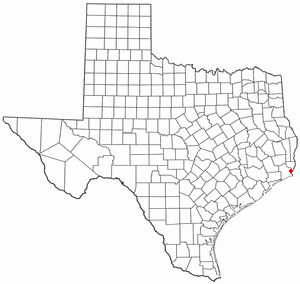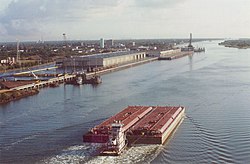Port Arthur, Texas: Difference between revisions
No edit summary |
|||
| Line 6: | Line 6: | ||
[[Image:TXMap-doton-PortArthur.PNG|right|Location of Port Arthur, Texas]] |
[[Image:TXMap-doton-PortArthur.PNG|right|Location of Port Arthur, Texas]] |
||
Port Arthur is located on the western bank of [[Sabine Lake]]. The [[Rainbow Bridge (Texas)|Rainbow Bridge]] across the [[Neches River]] connects Port Arthur to [[Bridge City, Texas|Bridge City]]. Port Arthur was founded by [[Arthur Edward Stilwell]] in the late 19th century, and was once the center of the largest oil refinery network in the world. <ref name="Hunt">Hunt, Herschiel. ''The History of Port Arthur''. Southern Publishing Concern, 1926.</ref> |
Port Arthur is located on the western bank of [[Sabine Lake]]. The [[Rainbow Bridge (Texas)|Rainbow Bridge]] across the [[Neches River]] connects Port Arthur to [[Bridge City, Texas|Bridge City]]. Port Arthur was founded by [[Arthur Edward Stilwell]] in the late 19th century, and was once the center of the largest oil refinery network in the world. <ref name="Hunt">Hunt, Herschiel. ''The History of Port Arthur''. Southern Publishing Concern, 1926.</ref> |
||
Since the 1940's there have been an influx of middle class [[African Americans]] - most of them coming from |
Since the 1940's there have been an influx of middle class [[African Americans]] - most of them coming from neighboring towns, this led to what is often refered to as [[white flight]] where many whites moved to neighboring towns such as [[Nederland]], [[Port Neches]], and Groves. By the late 1950's the city was segregated. The [[African Americans]] were forced to the west part of town. There the city built the [[Carver Terrace]] housing unit for low income blacks. By the 1970's [[African Americans]] were able to purchase homes on the other side of the KCS Railroad and many [[African Americans]] families expanded through other parts of the city. By [[2006]] census 60% of the city is now [[African American]] |
||
Currently Port Arthur has a diverse population. In addition to the African American and white communities and Cajun culture that is common in the area, there is also a thriving Vietnamese community and a growing Hispanic population. These additions to the local culture over the past several decades have brought diversity and exciting local flavor to this Southeast city. |
|||
Revision as of 00:04, 25 March 2007
Port Arthur is a city in Jefferson County within the Beaumont-Port Arthur metropolitan area and is situated in southeast Texas. As of the 2000 U.S. Census, the city had a total population of 57,755.
The Southeast Texas Regional Airport in Nederland serves Beaumont and Port Arthur.
Geography and History

Port Arthur is located on the western bank of Sabine Lake. The Rainbow Bridge across the Neches River connects Port Arthur to Bridge City. Port Arthur was founded by Arthur Edward Stilwell in the late 19th century, and was once the center of the largest oil refinery network in the world. [1] Since the 1940's there have been an influx of middle class African Americans - most of them coming from neighboring towns, this led to what is often refered to as white flight where many whites moved to neighboring towns such as Nederland, Port Neches, and Groves. By the late 1950's the city was segregated. The African Americans were forced to the west part of town. There the city built the Carver Terrace housing unit for low income blacks. By the 1970's African Americans were able to purchase homes on the other side of the KCS Railroad and many African Americans families expanded through other parts of the city. By 2006 census 60% of the city is now African American
Currently Port Arthur has a diverse population. In addition to the African American and white communities and Cajun culture that is common in the area, there is also a thriving Vietnamese community and a growing Hispanic population. These additions to the local culture over the past several decades have brought diversity and exciting local flavor to this Southeast city.
Port Arthur experienced an economic decline under the corrupt administration of Mayor J.P. "Pink" Logan. Pink Logan's regime inspired the "Clean Government Movement", established by Logan's primary adversary, W.C. Welch.[1] The efforts of the Clean Government Movement ultimately led the Texas Legislaure to establish the James Committee Report 1961. The James Committee, headed by Dallas Representative Tom James, identified corruption and graft at all levels of Port Arthur's municipal government and law enforcement. Unfortunately, the release of the report did not end corruption, rather it merely pushed all of the rackets into the underground.
Port Arthur has yet to recover from the effects of Pink Logan's political machine, and the city faces great challenges in the future given the predicted increase in hurricane activity.
Port Arthur has produced its fair share of famous individuals, including singing legend Janis Joplin and Dallas Cowboys coach, Jimmy Johnson. Currently, Port Arthur's profile has risen on the hip-hop scene with the emergence of the rap group UGK. Both members of UGK, Bun B and Pimp C, are from Port Arthur and often refer to their hometown in their songs. The phrase "Free Pimp C" has become an anthem in the Texas hip-hop music scene.
The Gulf Intracoastal Waterway runs past the city, separated from Sabine Lake by Pleasure Island. The 18.5 mile man-made island was created from dredged material from 1899 and 1908 Corps of Engineers projects
Port Arthur is located at 29°53′6″N 93°56′24″W / 29.88500°N 93.94000°WInvalid arguments have been passed to the {{#coordinates:}} function (29.884864, -93.939902)Template:GR.
According to the United States Census Bureau, the city has a total area of 372.3 km² (143.8 mi²). 214.8 km² (82.9 mi²) of it is land and 157.6 km² (60.8 mi²) of it (42.32%) is water.



Climate
| Monthly Normal and Record High and Low Temperatures | ||||||||||||
| Month | Jan | Feb | Mar | Apr | May | Jun | Jul | Aug | Sep | Oct | Nov | Dec |
|---|---|---|---|---|---|---|---|---|---|---|---|---|
| Rec High °F | 82 | 85 | 87 | 94 | 98 | 100 | 103 | 108 | 105 | 95 | 88 | 84 |
| Norm High °F | 61.5 | 65.3 | 72 | 77.8 | 84.3 | 89.4 | 91.6 | 91.7 | 88 | 80.5 | 70.9 | 63.9 |
| Norm Low °F | 42.9 | 45.9 | 52.4 | 58.6 | 66.4 | 72.3 | 73.8 | 73.2 | 69.4 | 59.6 | 50.8 | 44.5 |
| Rec Low °F | 14 | 20 | 23 | 32 | 46 | 56 | 61 | 60 | 45 | 30 | 22 | 12 |
| Precip (in) | 5.69 | 3.35 | 3.75 | 3.84 | 5.83 | 6.58 | 5.23 | 4.85 | 6.1 | 4.67 | 4.75 | 5.25 |
| Source: USTravelWeather.com [1] | ||||||||||||
Demographics
As of the censusTemplate:GR of 2000, there were 57,755 people, 21,839 households, and 14,675 families residing in the city. The population density was 268.9/km² (696.5/mi²). There were 24,713 housing units at an average density of 115.1/km² (298.0/mi²). The racial makeup of the city was 20.02% White, 43.70% African American, 0.45% Native American, 5.89% Asian, 0.02% Pacific Islander, 8.88% from other races, and 2.06% from two or more races. Hispanic or Latino of any race were 25.45% of the population.
There were 21,839 households out of which 33.2% had children under the age of 18 living with them, 42.6% were married couples living together, 19.7% had a female householder with no husband present, and 32.8% were non-families. 29.4% of all households were made up of individuals and 13.6% had someone living alone who was 65 years of age or older. The average household size was 2.61 and the average family size was 3.25.
In the city the population had 28.7% under the age of 18, 9.7% from 18 to 24, 26.2% from 25 to 44, 19.9% from 45 to 64, and 15.5% who were 65 years of age or older. The median age was 35 years. For every 100 females there were 91.1 males. For every 100 females age 18 and over, there were 86.8 males.
The median income for a household in the city was $26,455, and the median income for a family was $32,143. Males had a median income of $30,915 versus $21,063 for females. The per capita income for the city was $14,183. About 22.9% of families and 25.2% of the population were below the poverty line, including 35.2% of those under age 18 and 14.4% of those age 65 or over.
Education
The City of Port Arthur is served by the Port Arthur Independent School District.
Air Pollution
Port Arthur also has a significant air pollution problem that impacts the health of its residents. There are 4 large industrial complexes in the southern part of the city. These factories can have upsets, incidents where a dangerous situation at the plant necessitates the release of thousands of pounds of air toxins, often volatile organic compounds or nitrogen oxides, the two major contributors to ground-level ozone.[2] The chemicals are run through flares that incinerate almost all of the substance through combustion, but still emit dangerous amounts. The high incidences of asthma and cancer among residents in western Port Arthur is often attributed to the frequency and magnitude of the upsets.
Hurricane Rita
During the night of 23 September 2005 and through early morning of September 24, 2005, Port Arthur was damaged by the great winds and rain of Hurricane Rita. The damage was extensive and widespread, including flooding in Port Arthur's Downtown area. The Proctor Street Seawall held throughout the storm.*
Port Arthur had the highest recorded winds during Hurricane Rita's landfall—at 198mph[citation needed].
Famous natives of Port Arthur
- Janis Joplin: singer
- Grant Lyons: Friend of Janis Joplin, published writer of both fiction and nonfiction, journalist
- "Babe" Didrikson Zaharias: athlete and Olympic gold medalist
- Amy Acuff: five-time US Outdoors high jump champion
- Robert Rauschenberg: artist
- Becky Barksdale: musician
- UGK: rap group
- Stephen Jackson: basketball player
- Jimmy Johnson: football coach has a Highway in the city in honor named Jimmy Johnson Highway crossing HWY 365
- G.W. Bailey: Actor
- Clifford Antone: blues club owner
- Ken Webster: actor, director
- Aaron Brown: Univ. of Minn., NFL Kansas City Chiefs, Super Bowl MVP. High School two-time Basketball All-State, played one year of football and made All-State Fullback.
- Joe "Joe Boy" Washington: Oklahoma, Redskins, San Diego (How could you forget "Joe Boy"? One of NFL Best Monday Night performances.)
- Harry Gunner: College All-American Football and Basketball in JUCO; MVP of the Hula Bowl; Number 1 in NFL draft, chosen by Cincinnati Bengals; was on the front page of Sports Illustrated.
- Charles "Chucky" Baker: High School All-American (wr)
- Lee Richards: Lincoln High School, Southern University, No. 1 baseball draft pick. chosen by St. Louis Cardinals. Was on the front page of Sports Illustrated.
- James Gamble: All-American Basketball in college, SWAC Hall of Fame, street named after him in Port Arthur.
- Robert Perry: Had the fastest 100m time in high school in USA. Later attended LSU.
- Tommy Smiley: Lincoln High School, Lamar University, Cincinnati Bengals.
- Barbara Jacket: Lincoln High Coach, Prairie View Coach, Olympic Coach.
- Jordan Babineaux: NFL player
- Jonathan Babineaux: NFL player
- Eric Alexander: NFL player
- Terry Oubre: musician
- Jamaal Charles: University of Texas runningback
Notes
- ^ a b Hunt, Herschiel. The History of Port Arthur. Southern Publishing Concern, 1926.
- ^ "Port Arthur Stinks. Story by David Stiles." KPFT-FM, retrieved January 31 2007